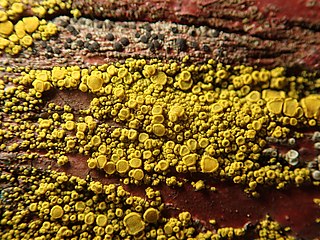
A lichen is a hybrid colony of algae or cyanobacteria living symbiotically among filaments of multiple fungi species, along with a yeast embedded in the cortex or "skin", in a mutualistic relationship.

Chaenotheca is a genus of lichenized fungi within the family Coniocybaceae. The sexual reproduction structures are a mass of loose ascospores that are enclosed by a cup shaped exciple sitting on top of a tiny stalk, having the appearance of a dressmaker's pin, hence the common name pin lichen. Genus members are also commonly called needle lichens. Photobiont partners for Chaenotheca include members of the algae genera Symbiochloris, Trebouxia, Trentepohlia, and Tritostichococcus.

Agyrium is a genus of saprophytic fungi in the family Agyriaceae. It probably evolved from a lichen ancestor, as it is closely related to many lichenized species of fungi.

The Baeomycetales are an order of mostly lichen-forming fungi in the subclass Ostropomycetidae, in the class Lecanoromycetes. It contains 8 families, 33 genera and about 170 species. As a result of molecular phylogenetics research published in the late 2010s, several orders were folded into the Baeomycetales, resulting in a substantial increase in the number of taxa.

Caloplaca is a lichen genus comprising a number of distinct species. Members of the genus are commonly called firedot lichen, jewel lichen. gold lichens, "orange lichens", but they are not always orange, as in the case of C. albovariegata. The distribution of this lichen genus is worldwide, extending from Antarctica to the high Arctic. It includes a portion of northern North America and the Russian High Arctic. There are about thirty species of Caloplaca in the flora of the British Isles.

Ochrolechia is a genus of crustose lichens in the family Ochrolechiaceae. These lichens typically form uneven, often thick, crust-like growths on various surfaces and are characterised by their white to pale grey thalli, which may have a greenish tint. The genus has a long evolutionary history, with fossils dating back to the Paleogene period, about 34 million years ago. Ochrolechia species have disc-like apothecia, which are usually yellowish or brownish-pink and often covered with a fine white powdery coating. The genus is widely distributed and includes both common and rare species, with some found in extreme environments such as arctic and alpine regions. Ochrolechia lichens produce diverse secondary metabolites, including orcinol depsides, depsidones, and xanthones.

Xanthoria is a genus of lichenized fungi in the family Teloschistaceae. Common names include orange lichen, orange wall lichen, and sunburst lichen. They can be identified by their characteristic squamulose morphology with distinctive "fairy cups".
Melanomma is a genus of fungi in the family Melanommataceae. It probably evolved from a lichen ancestor, as it is closely related to many lichenized species of fungi.

Ahtiana is a genus of lichenized fungi known as candlewax lichens in the family Parmeliaceae. A monotypic genus, it contains the single species Ahtiana sphaerosporella or the mountain candlewax lichen, found in western North America. This species was segregated from the genus Parmelia by Canadian lichenologist Trevor Goward in a 1985 publication. It had been suggested that the genus include A. aurescens and A. pallidula based on similarities in morphology, but this transfer is not supported by molecular analysis.

Punctelia is a genus of foliose lichens belonging to the large family Parmeliaceae. The genus, which contains about 50 species, was segregated from genus Parmelia in 1982. Characteristics that define Punctelia include the presence of hook-like to thread-like conidia, simple rhizines, and point-like pseudocyphellae. It is this last feature that is alluded to in the vernacular names speckled shield lichens or speckleback lichens.

Candelariella is a genus of bright yellow, ocher, or greenish yellow crustose or squamulose lichens in the family Candelariaceae. Members of the genus are commonly called eggyolk lichens, goldspeck lichens, or yolk lichens. The genus was circumscribed in 1894 by Swiss lichenologist Johannes Müller Argoviensis, with Candelariella vitellina assigned as the type species.
Perigrapha is a genus of fungi within the Arthoniales order that is parasitic on lichens. The genus has not been placed into a family.
Cryptothele may refer to:

Nesolechia is a genus of parasitic fungi in the family Parmeliaceae. All three species in the genus grow on lichens. Nesolechia probably evolved from a lichen ancestor, as it is closely related to many lichenized species of fungi.
André Aptroot is a Dutch mycologist and lichenologist. His primary research focus is on biodiversity, particularly tropical lichens, encompassing systematics, floristic surveys, and taxonomic reviews. A prolific researcher, he has published more than 500 scientific papers and described hundreds of new fungal and lichen species.
Xyleborus is a genus of lichen-forming fungi in the family Stereocaulaceae. It has two species. The genus was circumscribed in 2009 by Richard C. Harris and Douglas Ladd with Xyleborus sporodochifer assigned as the type species. A second species, X. nigricans, was added to the genus in 2015.
Helge Thorsten Lumbsch is a German-born lichenologist living in the United States. His research interests include the phylogeny, taxonomy, and phylogeography of lichen-forming fungi; lichen diversity; lichen chemistry and chemotaxonomy. He is the Associate Curator and Head of Cryptogams and Chair of the Department of Botany at the Field Museum of Natural History.

The following outline provides an overview of and topical guide to lichens.
James Donald Lawrey is a biologist, specialising in lichens. He is known for leading long-term monitoring projects, taxonomy and studies of the evolution of the fungi in lichens.

Robert Lücking is a German lichenologist, known for his extensive research on foliicolous lichens and his significant contributions to the taxonomy, ecology, and biodiversity of fungi and lichens. He earned his master's and PhD from the University of Ulm, focusing on foliicolous lichens. He has received numerous awards for his work, including the Mason E. Hale Award for his doctoral thesis, the Augustin Pyramus de Candolle prize for his monograph, and the Tuckerman Award twice for his publications in the scientific journal The Bryologist.












